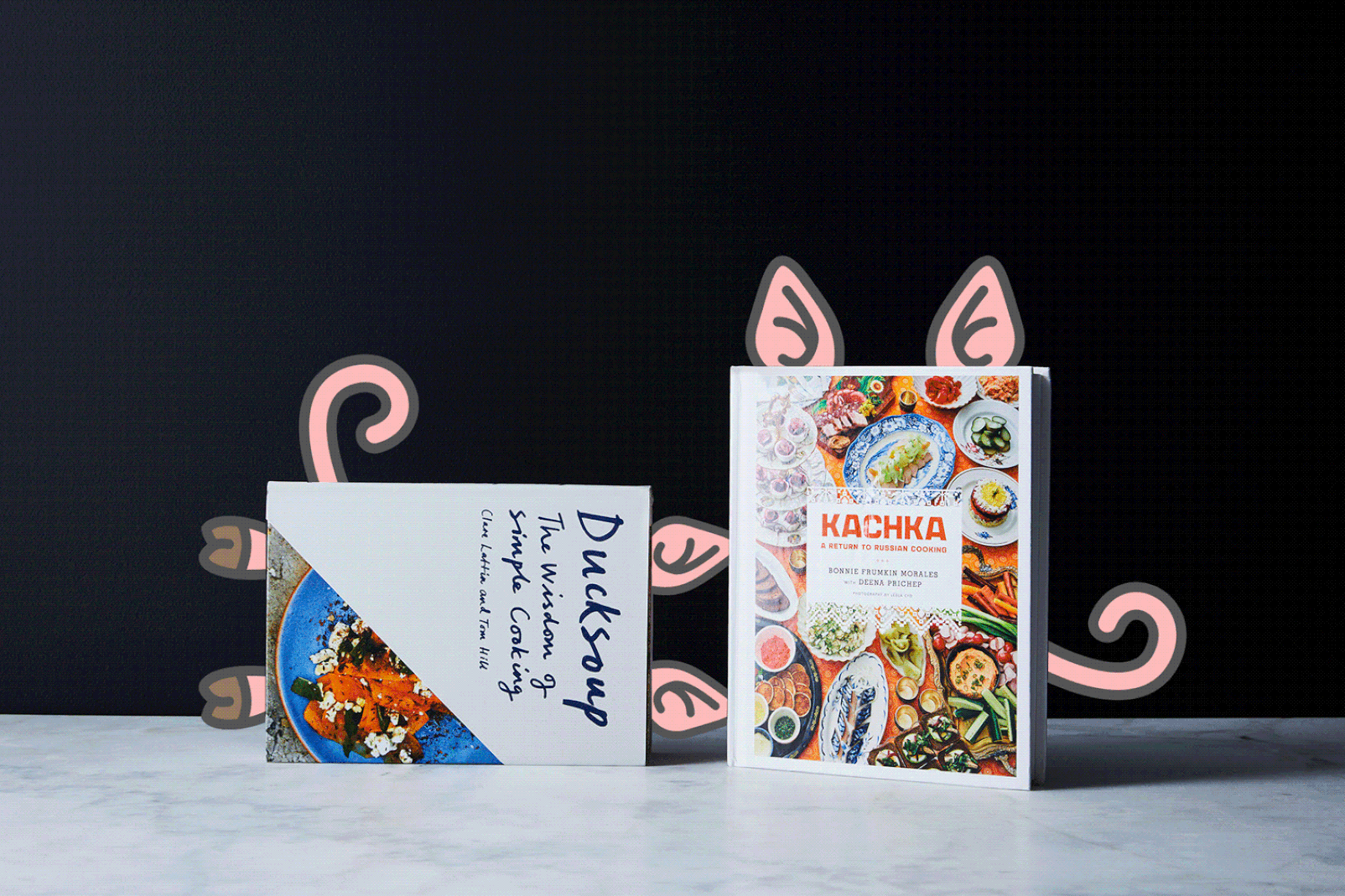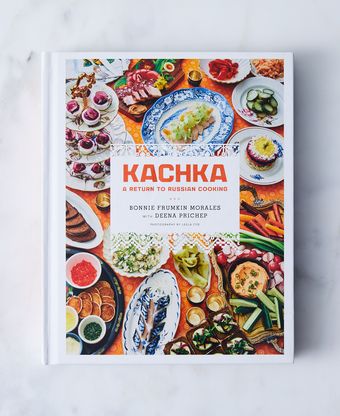You know Wendi McLendon-Covey from movies and television: She’s made you laugh in Bridesmaids, The Goldbergs, Reno 911!, and more.
What you may not know is she calls herself “not the worst cook in the world.” So she took Ducksoup by Clare Lattin and Tom Hill and Kachka by Bonnie Frumkin Morales and Deena Prichep for test-drives during her residency as a Piglet judge. She made everything from her new favorite pudding to a fried football—sort of. You’ll see.
After Wendi dives into both contenders and goes shopping for a few recipes from each (with varying degrees of success), she heads to the kitchen to make a wide array of dishes: The food in Kachka has roots in the former Soviet Union by way of the author’s mother and babushka. Meanwhile, the food of Ducksoup is what you’ll find at the London restaurant by the same name—a bit more off the cuff and inspired by the seasons.
Ultimately, Wendi advances one book to the next round. See which she picks here and why, along with her ridiculous cats that almost steal the show (sorry Wendi, sorry cookbooks):
Hi, I’m Wendi McLendon-Covey and I am so excited to be part of the Piglet Cookbook Competition. So, let’s get into it.
I was sent the following books. Kachka: A Return to Russian Cooking and Ducksoup: The Wisdom of Simple Cooking. Now, both of these cookbooks feature recipes from restaurants of the same name. Kachka is in Portland, Oregon, and Ducksoup is in London.
So, I’m not the worst cook in the world. I can follow a recipe. That’s one of the things that speaks to me about a cookbook—how easy it it to follow its recipes.
Kachka, I was very interested in because I know nothing about Russian cooking. As you go through the introduction, it says, “This is not a Russian cookbook.” What? It is a cookbook that features recipes from the former Soviet Union. So, you’ve got Ukrainian, Lithuanian, Belarusian. All those territories come together to make recipes in this book. And a lot of these recipes are heritage recipes from the author’s own mama and babushka.
In the introduction, it says, “Most of these recipes you can find your ingredients at your local supermarket.” Mmm, not really. Or at least that was true for me. I had to chase around to several supermarkets. And, yes, we do have a Russian market 15 miles away. But if you do find the ingredients, you are not going to be disappointed.
I tried the Chicken Kiev, and I have a photo of it here. Notice how my chicken kiev looks like a big chicken-fried football. That’s on me. I did not pound my chicken flat enough. But, it was delicious.
Being that I tried this cookbook around Christmas time, I wanted to do a lot of baking. So, I did the Poppyseed Chocolate Roll—again, this was a slow process, but it was worth it. Oh, it was worth it. It was like a chocolatey bread that’s not too sweet that you could serve it for brunch. You could use it for French toast. It was absolutely delicious, and we have a picture of it.
Apple Ponchiki with Thyme Sugar. OK, this made a mess of my kitchen. I am still finding flour in the nooks and crannies of my kitchen. But it was delicious. Here’s a picture. I made the thyme sugar with lemon thyme from my own garden.
The real showstopper of my journey through this cookbook was the Shkvarky with Buckwheat Blini and Lingonberry Mustard. You’ve never heard of that before, have you? So, shkvarky is basically pork fatback, but the recipe says you can just use bacon, which is what I did. I can’t be chasing around for shkvarky.The buckwheat blini with the bacon. The Lingonberry jam with the the pickled mustard seeds. Oh, my God. This is going to be my go-to brunch dish for the rest of my life.
One of the many things that I loved about this cookbook is that I felt like I really went on a journey with these people. This is a travelogue, this is a list of customs. You’re going to find everything in here from your babushka's remedies to a whole crash course on caviar, a crash course on pickling, a crash course on the Russian customs. My favorite was the Pyanka. This, to me, cemented for me how emotional a topic food is in this culture. And I loved it. The photography was beautiful. Like I said, this is not necessarily a cookbook for beginners. It takes a lot of pre-planning and pre-shopping. And a lot of chasing around. But thanks to Amazon, you know, you can do that. But I loved it and I think you’ll love it, too.
Now, the next book was the complete opposite. Ducksoup—simple cooking, simple recipes. I was really in the mood for this after going on this epic journey into the Russian territories. This book is all about taking, you know it’s not about reinventing the wheel, but it’s reminding you how simple flavors blended together can be very satisfying.
What I loved about this is, after Kachka, these recipes, in comparison, require very few ingredients. That really spoke to me. There’s a bit of a travelogue component to this book as well because the authors have picked up a lot of things from their own travels all over the world and incorporated them into these easy recipes. You’re gonna find some surprising ingredients. There’s a lot of sumac in these recipes. Or labne. Or tahini. But those little punches of the unexpected are some of the reasons that these simple recipes really popped for me.
One thing I tried was the Autumn Squash Garden Watercress Sheep’s Curd and Walnuts. Now, I would’ve never put those things together. I’m not that big of a fan of watercress, but I sure loved it in this recipe. I made it in 20 minutes. It was just a warm, friendly, gentle dish that made me eat my vegetables after the holidays. And I liked it.
Another recipe that I tried was the Cavolo Nero and Pappardelle. That’s a pasta dish. Cavolo Nero, I didn’t know what that was. What it is is Tuscan kale. It’s basically pasta with pesto sauce made from Tuscan kale. What I loved about it was that that beautiful bluish-green Tuscan kale gave the pesto a gorgeous color and it would have been perfect with a lemon chicken. Maybe it’s more of a Spring dish, but I like pesto all the time.
The showstopper form the Ducksoup cookbook was the Orange Blossom and Milk Pudding, Pistachio and Honeycomb. Now, I don’t know any beekeepers and couldn’t find any honeycomb, but I did use manuka honey and that was phenomenal. The orange blossom comes from orange blossom water that you really can get that at any supermarket. Hint, I found it in the mixers in the alcohol section. You blend that into this gentle milk pudding, and tempered with the manuka honey and the pistachios—it brought tears to my eyes. It was delicious. I will make this again. In fact, there’s some in my fridge right now. I keep making it. It’s delicious.
I did have one beef with this book. For the most part, I did love the way it was put together. There’s your really simple recipes. There’s recipes for when you have a little more time. There’s informative essays on the difference between pickling and fermenting. How to put together a good charcuterie plate. The benefits of biodynamic wine. A lot of content here. Very readable. Very digestible, pun intended. But what I had a problem with was the photography. I’m someone who needs to see a finished product of my dish. Here’s the side of this building. Well, unless I’m going to eat that, I don’t care about the side of this building. Here’s a perfect example. Dark Chocolate Mousse, Sour Cherries, and Pistachios. Well, someone loved it enough to finish the plate.
Really, I loved both of these books. I will keep both of these books and will cook from them often. But when it comes time to advancing a book to the next round, I gotta go with Kachka. But definitely buy Ducksoup because it is really good and you’re not going to be disappointed with these recipes.



45 Comments
Duck Soup I will skip for now as I have a lot of cookbooks that use all those middle eastern flavors, and I don't feel the need for more.
Where is the bracket?????
Otherwise, I thoroughly enjoyed the review, loved seeing photos of the dishes Wendi cooked and adored watching her cats!
But what I really want to know is WHY AREN'T WE TALKING ABOUT THE CATS? The back-to-the-camera pose of the cat on the left and the total dis that it conveys was priceless.